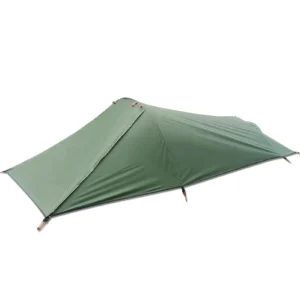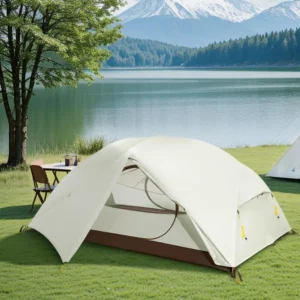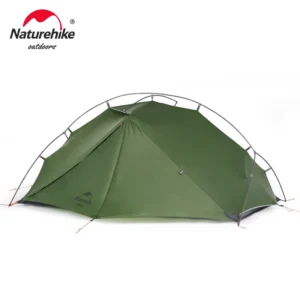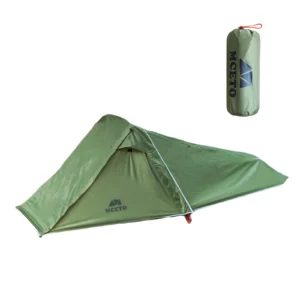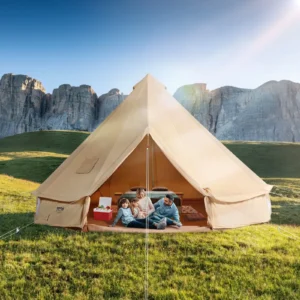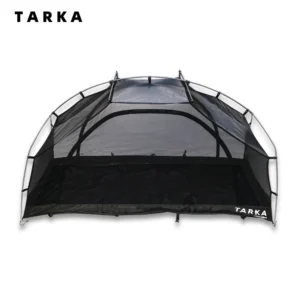1. Introduction: Why Tent Material Choices Matter for Backpackers
Every backpacker has experienced that moment – standing at the trailhead, shoulders already aching under a heavy pack, wondering if they could have somehow lightened the load. Among the items weighing you down, your tent likely represents one of the most significant opportunities for weight savings.
Tents form part of the backpacking “big three” – tent, backpack, and sleeping bag – typically the heaviest items in your pack. The materials used in tent construction can dramatically impact overall weight, with nearly identical tent designs varying by several pounds based solely on material choices.
When selecting tent materials, you’ll navigate what experts call the “weight-durability-cost triangle.” Optimize for one factor, and you’ll likely compromise on others. Understanding these trade-offs is essential for making informed choices that match your specific needs.
In this guide, you’ll discover:
– The fundamental tent materials and their weight implications
– How different fabrics perform in various conditions
– The hidden weight factors beyond just the tent body
– How to match materials to your adventure style
Knowing the difference between materials can transform your backpacking experience. Two-person tents can range from about 5 pounds down to under 2 pounds, with material selection being the primary factor in this dramatic difference.
Understanding compact shelters for two campers helps you make better decisions about your gear. The 20 percent rule in backpacking suggests your shelter should ideally represent no more than one-fifth of your total pack weight, making material selection crucial. The proper selection of your backpacking big 3 essential gear can dramatically reduce your overall load while maintaining necessary protection.
2. Understanding Key Tent Material Terminology
Before comparing specific materials, it’s helpful to understand the technical terms you’ll encounter in tent specifications:
Denier (D): This measures the thickness of individual fibers in fabric. Lower numbers mean thinner, lighter fabric (e.g., 10D vs 70D). A 20D fabric is approximately half the weight of a 40D fabric of the same material. However, lighter deniers generally sacrifice durability.
Hydrostatic Head (HH/mm): This measures waterproofness, expressed in millimeters of water pressure a fabric can withstand before leaking. Higher numbers mean better waterproofing. Most backpacking tents range from 1,200mm to 3,000mm for adequate protection.
Ripstop: A special weaving technique that incorporates stronger reinforcement threads in a grid pattern. This prevents tears from spreading beyond their initial point. Many premium backpacking tents use ripstop nylon or polyester.
GSM and oz/yd²: These measure fabric weight – grams per square meter (GSM) or ounces per square yard (oz/yd²). These metrics allow direct comparison between different materials regardless of denier.
Coatings: Treatments applied to fabrics to enhance waterproofing and durability. Common types include polyurethane (PU), silicone, and polyether urethane (PeU).
Single-wall vs. Double-wall: Single-wall tents combine the rainfly and canopy into one layer, saving weight but potentially increasing condensation. Double-wall tents separate these layers, adding weight but improving ventilation.
Understanding these terms helps decode marketing language and make meaningful comparisons between tents. For example, a tent with “20D ripstop nylon floor” tells you it uses lightweight fabric reinforced against tearing.
The relationship between fabric specifications and performance is complex, particularly when considering waterproof ratings for backpacking gear. Higher ratings don’t always translate to better real-world performance.
3. Primary Tent Fabrics: Weight Characteristics and Performance
3.1. Nylon and Silnylon
Nylon has been the backbone of backpacking tent construction for decades, offering excellent strength-to-weight ratio at a reasonable cost. Most backpacking tents use nylon in denier ranges from 10D (ultralight) to 70D (more durable).
Silnylon is nylon fabric impregnated with silicone, enhancing strength and water resistance while adding minimal weight. This treatment typically increases tear strength by 30-50% compared to untreated nylon.
Weight Impact:
– Ultralight nylon (10-20D): Approximately 1-1.5 oz/yd² (30-45 GSM)
– Standard nylon (30-50D): Approximately 1.5-2.5 oz/yd² (45-75 GSM)
– Durable nylon (60-70D): Approximately 2.5-3.5 oz/yd² (75-105 GSM)
Pros:
– Excellent strength-to-weight ratio
– Good tear resistance, especially with ripstop weave
– Relatively affordable compared to premium alternatives
– Wide availability and variety of options
Cons:
– Absorbs water and stretches when wet, requiring tent adjustments
– Degrades with UV exposure over time
– Requires coating for waterproofing
The weight difference becomes significant in real-world applications. A two-person tent using 30D nylon might weigh 3 pounds, while the same design using 15D fabric could drop to around 2.5 pounds.
Proper lightweight tent setup techniques become increasingly important with lighter-weight nylons, as they require more careful handling. Many backpackers find that ultralight backpacking tents made from silnylon provide an excellent balance between weight savings and durability.
3.2. Polyester and Silpoly
Polyester represents a popular alternative to nylon, with different performance characteristics despite similar appearance. Like nylon, it’s available in various deniers, typically 20D-75D for backpacking applications.
Silpoly (silicone-impregnated polyester) offers enhanced water resistance and strength similar to silnylon, but with some key performance differences.
Weight Impact:
– Ultralight polyester (20D): Approximately 1.2-1.7 oz/yd² (35-50 GSM)
– Standard polyester (40-50D): Approximately 1.7-2.7 oz/yd² (50-80 GSM)
– Durable polyester (68-75D): Approximately 2.7-3.7 oz/yd² (80-110 GSM)
Pros:
– Minimal stretch when wet (maintains tension better than nylon)
– Superior UV resistance (longer lifespan in sunny conditions)
– Less expensive than comparable DCF options
– Dries faster than nylon
Cons:
– Slightly heavier than equivalent denier nylon
– Generally less tear-resistant than nylon
– Typically more expensive than comparable nylon
The stability of polyester in wet conditions makes it particularly valuable for extended trips where rain is expected. A silpoly tent will maintain its shape during rainstorms, while a silnylon tent may sag and require readjustment.
Many waterproof backpacking tents utilize polyester or silpoly for their excellent performance in wet conditions, though they may carry a slight weight penalty compared to nylon alternatives.
3.3. Dyneema Composite Fabric (DCF/Cuben Fiber)
Dyneema Composite Fabric (DCF), formerly known as Cuben Fiber, represents the premium ultralight option in tent materials. Unlike woven fabrics, DCF consists of Dyneema fibers sandwiched between polyester films, creating an incredibly lightweight yet strong material.
Weight Impact:
– Lightweight DCF (0.34 oz/yd²): Approximately 10 GSM
– Standard DCF (0.5-0.8 oz/yd²): Approximately 15-25 GSM
– Heavy-duty DCF (1.0-1.43 oz/yd²): Approximately 30-45 GSM
Pros:
– Extremely lightweight (30-50% lighter than comparable nylon)
– Inherently waterproof without additional coatings
– Zero stretch when wet (maintains perfect pitch)
– Excellent tensile strength
– Highly resistant to UV degradation
Cons:
– Extremely expensive (5-10 times the cost of nylon/polyester)
– Poor abrasion resistance
– Difficult to repair in the field
– Noisy in wind and when handled
– Less breathable than woven fabrics
The weight savings with DCF are substantial. A two-person DCF tent might weigh 18 ounces while a similar silnylon version weighs 32 ounces – nearly a pound difference in your pack.
Many ultralight trekking pole tents utilize DCF to achieve their remarkably low weights, though the premium price means these shelters can cost several hundred dollars more than similar nylon models.
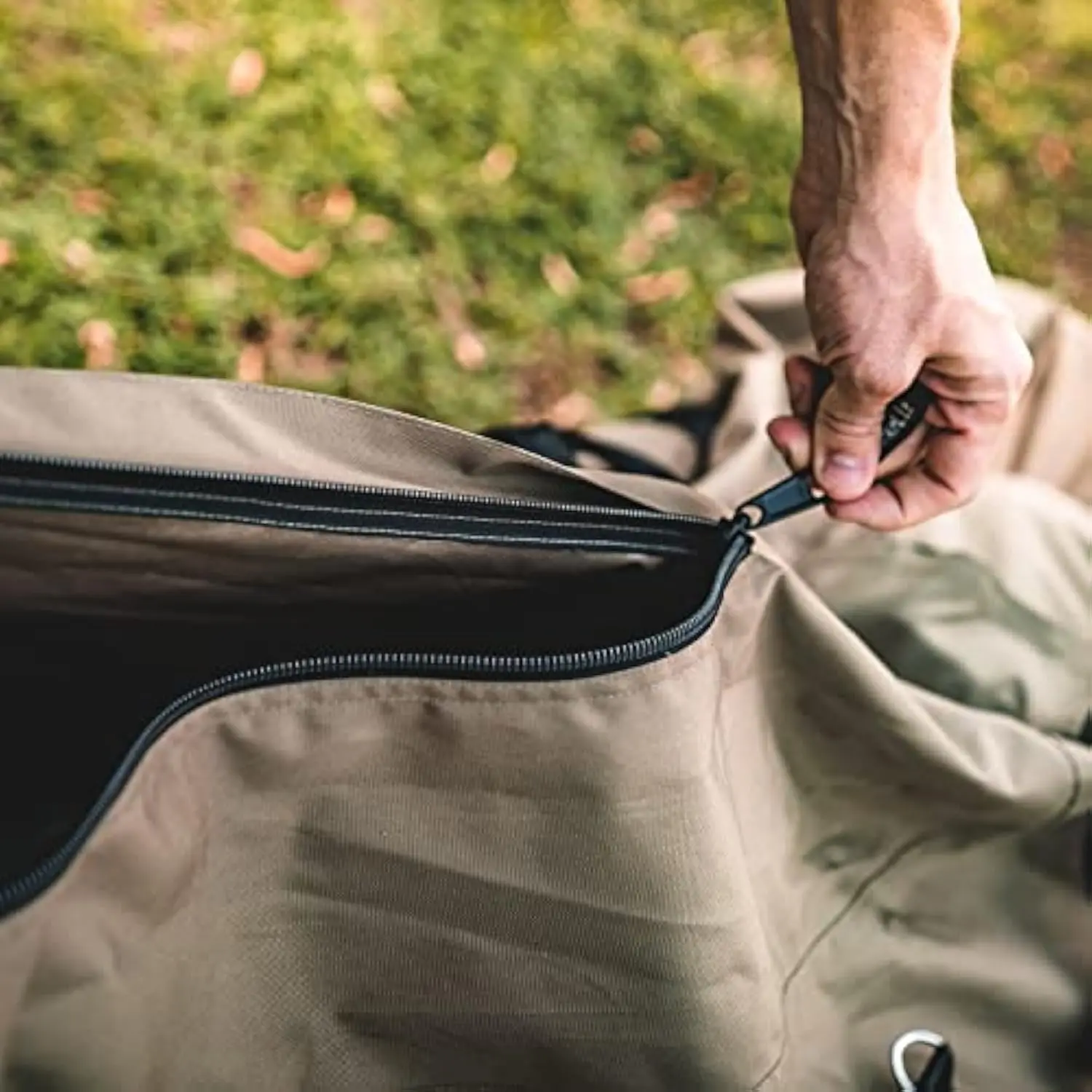
3.4. Other Materials (Canvas, Polycotton)
Traditional materials like canvas and polycotton blends are worth mentioning, though they’re rarely suitable for backpacking due to their excessive weight.
Weight Impact:
– Canvas: Approximately 10-24 oz/yd² (300-700 GSM)
– Polycotton: Approximately 7-12 oz/yd² (200-350 GSM)
These materials weigh 4-8 times more than comparable synthetic options, making them impractical for carrying long distances. However, they offer excellent durability, breathability, and a classic aesthetic that some campers prefer for car camping, base camps, or extended stays where weight isn’t a primary concern.
For those interested in traditional camping experiences, canvas camping tents provide exceptional durability and weather resistance when weight isn’t a limiting factor.
4. Waterproof Coatings: The Hidden Weight Factor
Tent waterproofing isn’t just about the base material – coatings significantly impact both weight and performance. These treatments represent a critical but often overlooked aspect of tent weight.
Polyurethane (PU) Coatings:
PU coatings add approximately 0.2-0.5 oz/yd² (6-15 GSM) to fabric weight. These traditional coatings create a waterproof layer on the inside of the tent fabric. They allow for easy seam-taping but are vulnerable to hydrolysis (chemical breakdown) in humid storage conditions.
Silicone Coatings:
Silicone treatments add roughly 0.1-0.3 oz/yd² (3-9 GSM) to fabric weight. Applied to both sides of the fabric (in silnylon/silpoly), silicone enhances tensile strength by up to 30% while providing excellent water repellency. However, silicone-coated fabrics can’t be seam-taped and require manual seam sealing.
Hybrid (Sil/PU) Coatings:
These coatings apply silicone to the outer face for durability and PU to the inner face for seam taping. They add approximately 0.15-0.4 oz/yd² (4.5-12 GSM) to fabric weight, balancing the benefits of both coating types.
PE (Polyether Urethane) Coatings:
PE coatings add about 0.3-0.6 oz/yd² (9-18 GSM) to fabric weight. They provide superior hydrolysis resistance compared to standard PU coatings, extending the waterproof life of the tent, but at a slightly higher weight penalty.
The thickness of these coatings directly affects hydrostatic head ratings. A 1,500mm rated fabric might use a thinner coating than a 3,000mm rated fabric of the same base material, resulting in a 5-10% weight difference.
Understanding materials used in waterproof hiking gear helps you make informed choices about the waterproofing systems in your tent and how they affect overall weight.
5. Comparative Analysis: Tent Material Weight-to-Performance Ratio
When selecting tent materials, understanding the comparative weight-to-performance ratio helps identify the best option for your needs:
| Material | Relative Weight | Durability | Waterproofness | UV Resistance | Packability | Cost Range | Ideal Applications |
|---|---|---|---|---|---|---|---|
| DCF/Cuben Fiber | Lightest (1.0) | Moderate | Excellent | Excellent | Excellent | $$$$ | Ultralight backpacking, thru-hiking |
| Silnylon | Light (1.8) | Good | Very Good | Fair | Good | $$ | General backpacking, lightweight trips |
| Silpoly | Light-Moderate (2.0) | Moderate | Very Good | Good | Good | $$ | Wet conditions, extended trips |
| PU-Coated Nylon | Moderate (2.2) | Good | Good | Poor | Good | $ | Budget backpacking, occasional use |
| PU-Coated Polyester | Moderate (2.3) | Moderate | Good | Moderate | Good | $ | Budget backpacking, sunny conditions |
| Canvas/Polycotton | Very Heavy (8.0) | Excellent | Moderate | Good | Poor | $$$ | Car camping, base camps |
Note: Relative weight uses DCF as baseline (1.0) for comparison
This table reveals important insights:
– No material excels in all categories – each involves trade-offs
– The lightest materials (DCF) come with significant cost premiums
– Midrange options (silnylon/silpoly) offer the best balance for most users
– Durability and weight generally have an inverse relationship
For most backpackers, the middle options provide the best value. A typical two-person silnylon tent weighs approximately 2.5-3.5 pounds, while DCF models weigh 1.5-2.5 pounds but cost substantially more.
Choosing the ultimate compact shelter for two requires carefully balancing these material considerations against your specific needs, budget, and weight priorities.
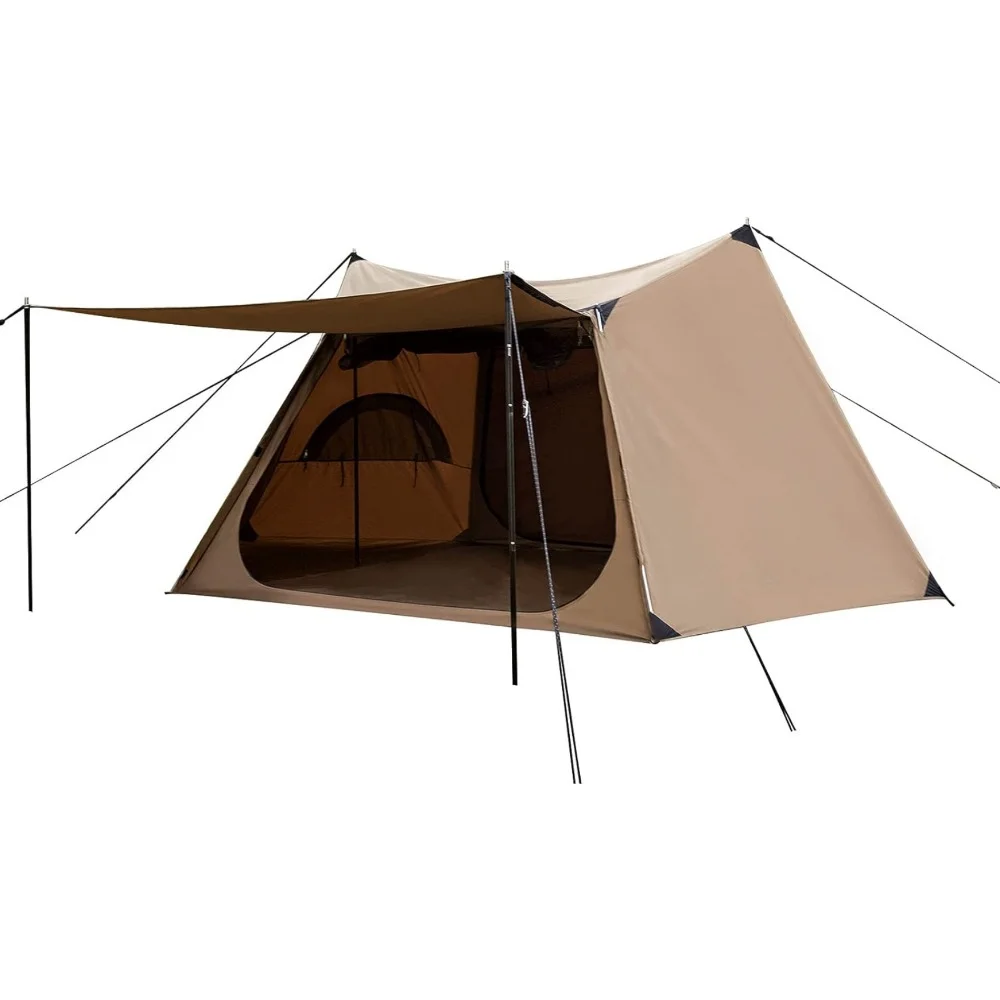
6. Beyond Fabric: Other Weight Contributors in Tent Systems
While fabric choices significantly impact tent weight, several other components contribute to the overall package weight:
Tent Design:
Single-wall tents eliminate the separate rainfly, saving 20-30% weight compared to double-wall designs, but often compromise on ventilation. Non-freestanding tents that use trekking poles instead of dedicated tent poles can save 8-16 ounces but require suitable ground for staking.
Pole Materials:
– Aluminum: Standard for backpacking (7-9 oz for a typical 2-person tent)
– Carbon fiber: Premium ultralight option (4-6 oz for comparable setup, 30-40% lighter than aluminum)
– Fiberglass: Budget option too heavy for serious backpacking (12-16 oz for comparable setup)
Stakes and Guy Lines:
These often-overlooked items can add 3-8 ounces to your pack weight. Lightweight aluminum stakes weigh about 0.3-0.5 oz each, while titanium shepherd’s hook stakes weigh just 0.2 oz each. Dyneema guy lines save about 40% weight compared to nylon cords.
Inner Tent Materials:
The choice between no-see-um mesh (lighter, better ventilation) and solid fabric panels (warmer, heavier) affects both weight and temperature regulation. Full mesh inners can save 2-4 ounces but sacrifice warmth in cold conditions.
These components together can create weight differences of 1-2 pounds between otherwise similar tents. For instance, freestanding backpacking tents typically weigh more than non-freestanding models but offer greater flexibility in pitching locations.
7. Matching Materials to Your Adventure Style
Different adventure styles demand different material priorities:
Ultralight Backpacking/Thru-Hiking:
– Best Materials: DCF for premium options (18-25 oz total tent weight); 10-20D silnylon/silpoly for budget-conscious (25-35 oz total weight)
– Material Priority: Minimum weight above all else
– Considerations: Gentler handling required; consider durability for trips longer than 1-2 months
Weekend Backpacking:
– Best Materials: 20-30D silnylon or silpoly (30-45 oz total tent weight)
– Material Priority: Balanced weight and durability
– Considerations: Greater durability margins reduce stress about site selection
Harsh Conditions/Mountaineering:
– Best Materials: 30-70D silnylon for extreme conditions; DCF for premium lightweight mountain shelters
– Material Priority: Reliability and strength
– Considerations: Higher denier floors (50-70D) for rocky terrain; higher hydrostatic head ratings (3000mm+)
Family/Recreational Camping:
– Best Materials: 40-70D polyester or nylon for durability when weight is less critical
– Material Priority: Durability and cost-effectiveness
– Considerations: UV resistance for extended setup periods; ease of repair
Environmental factors should influence your choice. Desert campers should prioritize UV-resistant materials like polyester or DCF. Those in humid forests might prefer quick-drying silpoly that doesn’t stretch when wet. Alpine adventurers need high hydrostatic head ratings and strength against wind.
Mastering the art of lightweight backpacking involves aligning material choices with your specific adventure style and environmental conditions.
8. Maximizing Lifespan: How Material Choice Affects Maintenance Needs
Your tent material selection directly impacts maintenance requirements and longevity:
Nylon & Polyester Care:
– Clean with gentle soap and water; avoid harsh detergents
– Fully dry before storage to prevent mildew and coating hydrolysis
– Reapply DWR (Durable Water Repellent) treatments annually
– Store loosely in dry, cool location away from direct sunlight
DCF/Cuben Fiber Care:
– Clean with water only; avoid soap when possible
– Simple to dry due to non-absorbent nature
– No DWR needed; occasional wipedown maintains performance
– Requires gentle handling to prevent creases becoming permanent
– Store flat or loosely rolled rather than tightly stuffed
Coating Maintenance:
– PU coatings need thorough drying to prevent hydrolysis
– Silicone coatings last longer but may need occasional refreshing
– Watch for flaking or peeling as signs of coating failure
Seam Maintenance:
– Silicone-treated fabrics require manual seam sealing with silicone sealant
– PU-coated fabrics typically have factory-taped seams that may need occasional reapplication
Proper care dramatically extends tent life, especially for PU-coated fabrics which are vulnerable to hydrolysis when stored damp. DCF tents typically require less maintenance but need more careful handling to prevent physical damage.
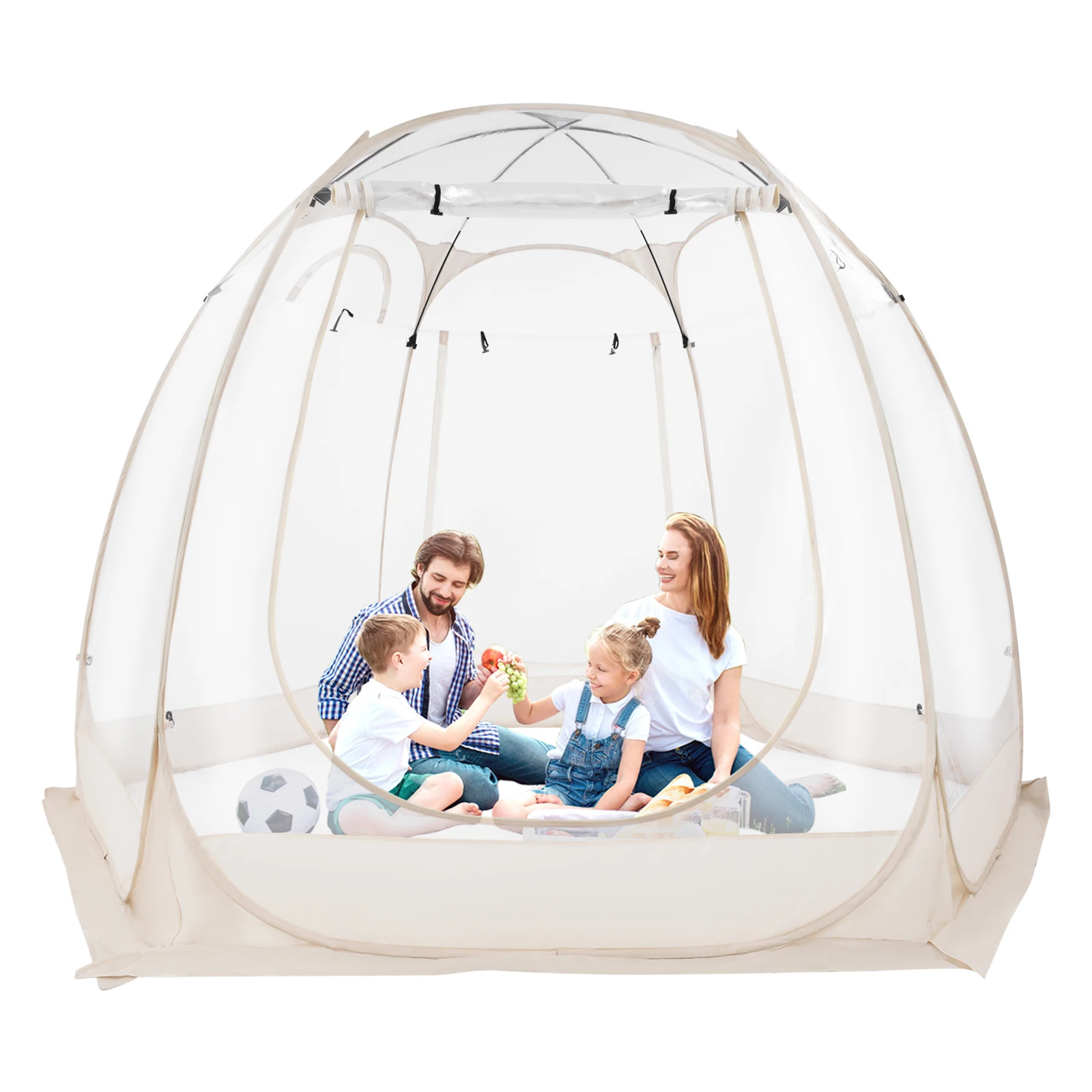
Understanding proper tent packing tips helps prevent damage during transport and storage, extending the life of your lightweight shelter regardless of material choice.
Lightweight Backpacking Tent, Ultralight Backpacking Tent, Ultralight Bivy Tent
Ultralight Single Person Camping Tent with Aluminum Poles for 3-Season Backpacking Waterproof DesignPrice range: $94.88 through $326.82 Select options This product has multiple variants. The options may be chosen on the product pageLightweight Backpacking Tent, Ultralight Backpacking Tent, Waterproof Backpacking Tent
$391.05 Select options This product has multiple variants. The options may be chosen on the product pageUltralight Backpacking Tent, Ultralight Dome Tent, Winter Camping Tent
Price range: $369.63 through $370.07 Select options This product has multiple variants. The options may be chosen on the product pageBackpacking Tent with Vestibule, Freestanding Backpacking Tent, Lightweight Backpacking Tent
Price range: $446.89 through $447.22 Select options This product has multiple variants. The options may be chosen on the product page- $1,221.93 Select options This product has multiple variants. The options may be chosen on the product page
Ultralight Backpacking Tent, Ultralight Trekking Pole Tent
Price range: $350.87 through $351.98 Select options This product has multiple variants. The options may be chosen on the product page
9. Making Your Decision: Balancing Weight, Performance, and Budget
When making your final tent material decision, consider these key factors:
Budget Considerations:
– Entry-level: PU-coated nylon/polyester ($150-300 range)
– Mid-range: Silnylon/silpoly ($250-450 range)
– Premium: DCF/Cuben Fiber ($500-700+ range)
Usage Frequency:
– Occasional use (2-5 trips yearly): Standard materials suffice
– Regular use (monthly trips): Invest in silicone-treated fabrics
– Heavy use (guide/professional): Consider premium materials despite cost
Environmental Conditions:
– Varied conditions: Versatile silnylon balances properties
– Wet environments: Silpoly minimizes stretch when wet
– Harsh UV exposure: Polyester or DCF resist degradation
– Abrasive terrain: Higher denier floor fabrics (50D+)
Personal Priorities:
– Maximum weight savings: Accept higher cost and lower durability
– Budget constraints: Accept moderate weight increase
– Durability concerns: Accept 8-16 oz weight penalty for higher denier
For most backpackers, silnylon or silpoly in the 15-30D range hits the sweet spot of weight, durability, and cost. Those logging serious miles on thru-hikes might justify the premium cost of DCF for its weight savings. Weekend warriors might prefer slightly heavier but more durable and affordable options.
The variety of camping shelter options for two ensures you can find the right balance based on your specific priorities and usage patterns.
10. Final Considerations: When to Prioritize Weight Savings vs. Durability
Q: Is ultralight always worth the cost?
A: Not necessarily. For weekend trips or journeys under 100 miles, the functional difference between a 2-pound and 3-pound tent is minimal compared to the cost difference. However, on thru-hikes where you’ll carry the tent for 2,000+ miles, even small weight savings multiply significantly.
Q: When should I choose durability over minimum weight?
A: Prioritize durability when camping in rough terrain with sharp rocks or abrasive surfaces, when sharing the tent with children or pets, when your trips involve extended stays in a single location, or when your budget limits replacement options.
Q: How much weight difference actually matters?
A: Experienced backpackers suggest meaningful weight savings start at 8 ounces (half a pound) for a single piece of gear. Saving 1-2 pounds on your shelter creates noticeable comfort differences during long days on trail. Remember that small savings across multiple items compound significantly.
The ideal balance varies by individual. Some hikers willingly carry extra ounces for better sleep and protection, while others prioritize moving fast and light. The materials in lightweight trekking shelter materials continue to evolve, offering increasingly better balances of weight and durability.
Ultimately, the perfect tent material is the one that helps you enjoy your wilderness experience while providing reliable shelter that you trust, no matter what conditions you encounter.


